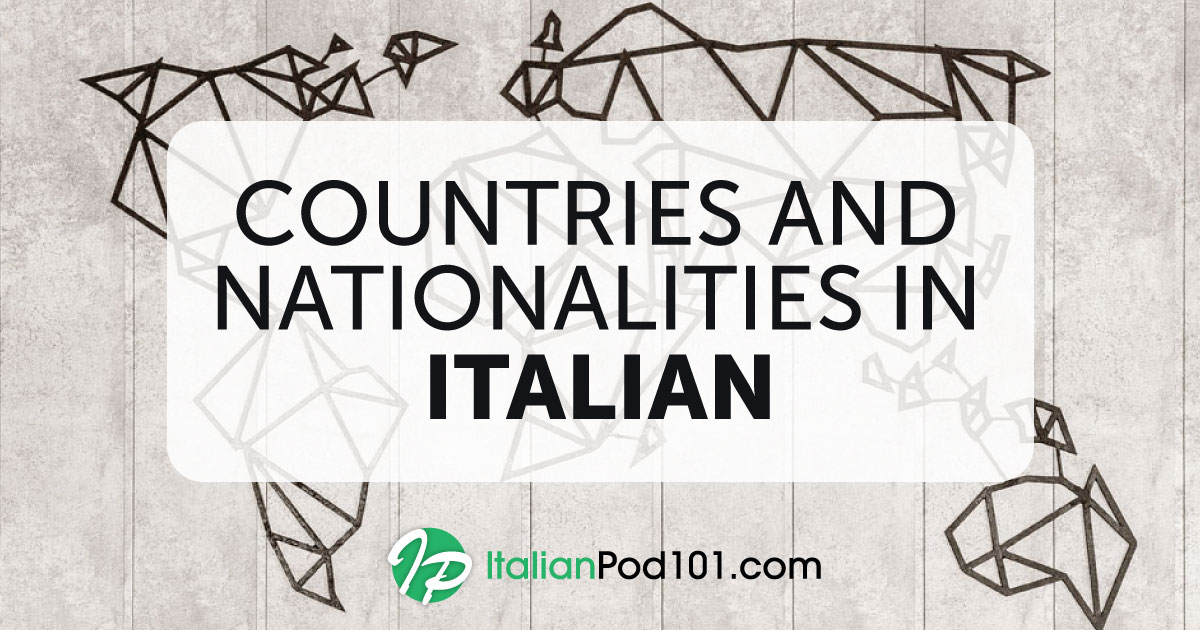
Have you ever wondered what makes Italian so musical? Among other reasons, there’s the fact that the rhythm inside the sentences is set by raising and lowering one’s tone of voice, dictated by…yes, you guessed right! The accento, which is how you say “accent” in Italian.

Accents and alternation of vowels make Italian so musical!
Accents are little (and often invisible) signs that help us speak and write correctly. That’s why it is so important to get Italian accent marks right on the page and to know the few rules that govern them. Ready to go? Start with a bonus, and download the Must-Know Beginner Vocabulary PDF for FREE! (Logged-In Member Only)
 Table of Contents
Table of Contents
- Introduction to Italian Accents
- Italian Accents and Their Functions
- The Most Important Italian Accent Mark of All (È vs. E)
- Are Italian Accent Marks Optional?
- Homograph Words (Same Words, Different Meanings)
- A Brief History of Italian Accents
- How to Type Italian Accents
- How to Get All Your Italian Accents Right with ItalianPod101.com!
1. Introduction to Italian Accents
First of all, let’s clarify an important point. In this article, we’ll be focusing only on orthographic signs, and not on the wonderful variety of regional variations with which Italians talk. That is a totally different topic, even though it also has to do with the musicality of the Italian language. But keep checking the ItalianPod101.com blog because in the future, you might discover just how to do an Italian accent!
The accents we’ll be talking about are those little orthographic signs that you write on top of vowels to give a syllable prominence or emphasis, basically to indicate that your voice has to stop there for an instant. In Italian, the only letters with accents are: à, è, é, ì, ò, ù.
When we talk, even if we don’t realize it, we put the accent on every word we say. And rightly so, because each word has an accent. But in writing, it’s rarely obligatory to indicate the accent, given that the Italian words with accent marks are a minority compared to those without.
In Italian, you’ll find only two accents:
- grave accent (`) as in città (“city”)
- acute accent (´) as in perché (“why”)
In the past, there used to be a circumflex accent (^) in specific cases, but it has—luckily—been dropped.
2. Italian Accents and Their Functions
Recapping, there are two types of Italian accents (acute and grave), and they have two functions:
- They indicate on which syllable to put the stress when you speak.
- They indicate if the vowel is open (grave = `) or closed (acute = ´).
In the first case, the only time it’s obligatory to put the accent mark in Italian is when the stress falls on the last syllable. These are called parole tronche (“truncated words”).
Roma è una bellissima città. (“Rome is a beautiful city.”)
I soldi non danno la felicità. (“Money does not give happiness.”)
La pazienza è la virtù dei forti. (“Patience is the virtue of the strong.”)

Is it with an accent or without…?
Notice how when the accent on the last syllable falls on the vowels a, i, o, or u, the accent is always grave: à, ì, ò, ù. If it falls on the vowel e, it could be grave (è) or acute (è), depending on the open or closed pronunciation of the vowel. (You can watch this video on Italian accents when pronouncing vowels for more information.)
For example, it’s acute with the causal conjunctions perché (“why” / “because”), affinché (“so that”), cosicché (“so”), giacché (“since”), poiché (“because”), etc., or on the compound words of tre (“three”), ventitré (“twenty-three”), trentatré (“thirty-three”), etc. In most other cases, it is grave.
To know when to put the accent, it helps to remember that all of the words in English that end in -ty (city, society, variety, immensity, etc.) will end in -tà in Italian (città, società, varietà, immensità, etc.). Note that they end with the à accent.
Then, there’s a certain number of monosyllabic words that are composed of just one syllable and need to have an accent. The small Italian words with accent marks are:
- Dà (“She/He/It gives”)
- Là, Lì (“There”)
- Sì (“Yes”)
- Tè (“Tea”)
- È (“It is”)
- Né (“Nor” / “Neither”)
- Sé (“Oneself”)
- Ciò (“That,” as a pronoun)
- Già (“Already”)
- Giù (“Down”)
- Più (“More”)
- Può (“He can”)
Other places where you need to consistently put the accent? Here they are:
- On the third person singular of the passato remoto (“remote past,” which is the equivalent of the preterit past). This is actually a bit more advanced. Do you want to find out more about it?
- Andò (“He went”)
- Mangiò (“She ate”)
- Dormì (“He slept”)
- On the first and third person singular of the future tense:
- Andrò / Andrà (“I will go” / “He will go”)
- Mangerò / Mangerà (“I will eat” / “She will eat”)
- Dormirò / Dormirà (“I will sleep” / “He will sleep”)
- On all the names of the days, except for sabato and domenica (“Saturday” and “Sunday”).This is because they are compounds of the word dì, which is another way to say giorno (“day”).
- Lunedì (“Monday”)
- Martedì (“Tuesday”)
- Mercoledì (“Wednesday”)
- Giovedì (“Thursday”)
- Venerdì (“Friday”)
3. The Most Important Italian Accent Mark of All (È vs. E)
The accented è in Italian is extremely important. Being the third person singular of the verbo essere (“verb ‘to be’”), you can imagine just how useful it is in your writing and how often you’ll have to write it.
That’s why Italian teachers can overlook some spelling and grammar mistakes, but one thing that will surely result in a red mark on your homework is to leave out the ` accent of è (“it is”) or to put it on e (“and”).

Beware! È vs. E is a red pen mistake!
In fact, in this case, it’s not only a matter of style, but it directly affects the meaning of the sentence. And since both parts (conjunction and verb “to be”) are so common and essential in any sentence, it’s clear why it’s so important to write them correctly. To help children remember if they need to write e with an accent or not, Italian teachers use this little rhyme with kids:
E che lega / È che spiega (“E that ties / È that explains”).
Try and repeat it a few times to memorize it. And if you still need more practice, check out one of the many resources on ItalianPod101.com.
4. Are Italian Accent Marks Optional?
Accents on parole tronche (“truncated words”), those words where the stress falls on the last syllable, are the only case in which accents are not optional. And—in theory—you should respect the correct orthography of the accent (basically the direction you write it ` vs. ´). But beware that nowadays, many Italians don’t pay much attention to it, especially with all the fast writing in chats and on phones…
When the stress falls inside the words, it’s not mandatory to write the accent. However, it’s extremely useful to clarify the pronunciation (yes, sometimes even Italians can get confused on the correct way to pronounce long words…). You’ll also find it useful in distinguishing cases in which two words look the same, but have different meanings depending on where the accent falls or what kind of accent it is. In this case, the choice of whether to use the accent or not is left to the writer, depending on the degree of ambiguity of the context. As in lèggere (“to read”) vs leggère (“light” f. pl.).
- Mi piace molto lèggere storie leggère. (“I really like to read light stories.”)
Most of the time, you’ll only see these accents in Italian dictionaries when you’re looking up the definition of the word.
5. Homograph Words (Same Words, Different Meanings)
The example above perfectly shows the other function of Italian accents, which is phonetic rather than orthographic. This means that it impacts the pronunciation and not the writing. These accents help you know how to pronounce any given word, and they clear things up in case of homographs, which are two words that are written the same way but have different meanings depending on where the accent falls.

Homograph words…what are those?
1- Same accent, different position
To better understand the importance of Italian accent marks’ pronunciation, here’s a list of Italian words with hidden accent marks that have different meanings depending on the position or the type of accents. But remember that these accents aren’t usually written, and they only appear in dictionaries.
- Lèggere / Leggère (“To read” / “Light”)
- Meta / Metà (“Goal” / “Half”)
La meta di quest’anno è le metà dell’anno passato. (“This year’s goal is half of last year’s.”)
- Prìncipi / Princìpi (“Princes” / “Principles”)
La storia è piena di prìncipi senza princìpi. (“History is full of princes with no principles.”)
- Capitàno / Càpitano (“Captain” / “They happen”)
Il capitàno ha detto che sono cose che càpitano. (“The captain said that these things can happen.”)
- Áncora / Ancòra (“Anchor” / “Yet” or “Still”)
La nave non ha ancòra gettato l’àncora. (“The ship has not yet thrown the anchor.”)
2- Same position, different accent
In other cases, the accent is in the same place, but it’s a different type (acute vs. grave). When this happens, the meaning changes as well, like in these examples.
- La bótte (“the barrel”) vs. Le bòtte (“the beatings”)
- Affètto (“affection”) vs. Affétto (“I slice”)
- Pèsca (“peach”) vs. Pésca (“he fishes”/”fishing”)
- Èsca (“bait”) vs. Ésca (“she leaves,” subjunctive of uscire)
Even for an Italian ear, it’s not always easy to hear the difference, especially since regional accents might influence the pronunciation. So it’s always easier to make out the difference based on the context of the sentence.
6. A Brief History of Italian Accents

Old Italian has a lot more accents…
So now you know that accents are sometimes there (we pronounce them), but aren’t really there (we don’t write them). Do you wonder why?
Accents in all romance languages come from the Greek. In Italy, up to the 19th century, there were no set rules and everybody used them as they liked…kind of. This is why, if you try and read a very ancient Italian text, you might find a lot of accents that today aren’t written anymore. And it’s just recently that the grammaticians have gotten together and set the rules that you’ve just learned here.
7. How to Type Italian Accents
Now, you might be wondering: “How do I type Italian accent marks?”
Sometimes, the biggest challenge when you write in a different language is to find unfamiliar letters and accents on your keyboard. Luckily, in Italian, you only have to worry about è, é, à, ì, ò, ù. So, here’s a little guide to help you learn how to write Italian accents.
1- On phones
Smartphones with a touchscreen normally have a very useful feature. If you hold your finger on a letter, all of the possible combinations and variations of that letter will pop up, including the accents.
2- On an Italian keyboard
If you happen to be in Italy, and you’re using an Italian keyboard (at a friend’s house, a library, or an internet cafè), you’ll find the vocali accentate (“accented vowels”) on the right side of the keyboard (à, è, é, ì, ò, ù). Very convenient! However, you won’t find uppercase È (“It is”) on the keyboard. But since it’s the only one that you will ever really need, you can copy-paste from another text, for example here: È! 🙂

Combination of keys will write à è é ì ò ù
3- On other keyboards
However, if you need to write Italian accent marks on keyboards that aren’t Italian, you’ll need a little patience and some trial and error before you’re able to write that perfect letter to your friend or finish your Italian homework.
On keyboards that have the ` and ´ keys, you normally just need to press one of those keys, followed by the vowel you need the accent on.
For the grave accent:
- à = ` then press the ‘a’ key.
- è = ` then press the ‘e’ key.
- ì = ` then press the ‘i’ key.
- ò = ` then press the ‘o’ key.
- ù = ` then press the ‘u’ key.
For the acute accent:
- à = ´ then press the ‘a’ key.
- é = ´ then press the ‘e’ key. (The only one you will really need.)
- í = ´ then press the ‘i’ key.
- ó = ´ then press the ‘o’ key.
- ú = ´ then press the ‘u’ key.
4- On a Mac
To type Italian accent marks on Mac keyboards, for the grave accent you’ll have to press the Option key, the tilde (~) key, and then the vowel you need to put the accent on:
- à = option + tilde (~) / then press the ‘a’ key.
- è = option + tilde (~) / then press the ‘e’ key.
- ì = option + tilde (~) / then press the ‘i’ key.
- ò = option + tilde (~) / then press the ‘o’ key.
- ù = option + tilde (~) / then press the ‘u’ key.
To write with the acute accent, you’ll have to press the Option key, the “e” key, and then the vowel you need to put the accent on, as follows:
- à = option + ‘e’ key / then press the ‘a’ key.
- é = option + ‘e’ key / then press the ‘e’ key again. (The only one you will really need.)
- í = option + ‘e’ key / then press the ‘i’ key.
- ó = option + ‘e’ key / then press the ‘o’ key.
- ú = option + ‘e’ key / then press the ‘u’ key.
5- On search engines
One thing that you won’t have to worry too much about is using the right accent when you’re looking something up on a search engine. Engines, in fact, give you full results, whether you put the accent or not.
For example, if you search meta on an Italian search engine, in the results you’ll find links, articles, and definitions about both the goal (meta) of this year’s spending review and the difference between metà and mezza (both, in fact, mean “half”).
8. How to Get All Your Italian Accents Right with ItalianPod101.com!
Are you ready now to write a perfect letter, a perfect resume, or a motivational letter? Are you confident enough to chat comfortably with your Italian friends via messages and chats?
Making progress in learning a language becomes easier once you have the right tools. And what could be better than free resources, mobile apps, a personalized learning system, or audio and video lessons to help you improve more everyday? All of this and more you’ll find on ItalianPod101.com, the Innovative Language site for on-the-go learning. Check it out!










